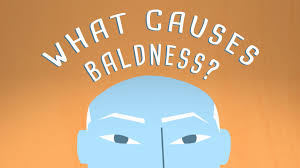Why do some people go bald?

Have you noticed how your father or your grandfather may be losing their hair? There’s actually a scientific explanation for that.
Let’s try to decode this problem.
Contents
How does hair growth work?
Our hair is made up of a protein called keratin. A structure known as hair follicles is responsible for the hair’s growth throughout our life cycle. The hair growth process follows a three-step cycle:-
Hair Growth Cycle
The first one being Anagen, which pushes up our hair by one-centimeter per month. Generally, this stage lasts for two to seven years. Primarily, it’s this stage that actually increases the length of our hair.
It is then followed by the second phase called Catagen, also known as the regressing stage. This phase compels the hair follicles to contract which in turn cuts its blood supply. It lasts for two to three weeks.
The final stage of this cycle is called Telogen, the resting phase. This period goes on for about ten to twelve weeks. This phase can lead to about 200 hairs being shed in a day. Not to fret, it is all normal. Thereafter, the cycle begins again from the first stage and goes on.
However, this normal cycle isn’t experienced at the same rate by everyone. 95% of men’s baldness is contributed to by what is known as Male Pattern Baldness.
What is Male Pattern Baldness?
Genetic inheritance can be one cause of baldness in people.
A gene known as dihydrotestosterone or DHT causes further shrinkage in the follicles. It follows the Norwood Scale to facilitate the loss of hair. According to this, the first area that witnesses hair loss is that along with the temples. The hair on the crown area follow suit as they start receding in a circular pattern. This entire process eventually leads all these balding spots to meet which barely leaves any hair around the temples. Only a patch of hair at the back of the head survives this reaction.
Other factors causing hair loss
Prolonged periods of being under pressure and stress release signals in the scalp which shock the hair follicles, thereby leading to loss of hair.
Women often experience hair loss during the post-partum period i.e. after the birth of their child.
People going through chemotherapy experience something similar.
Despite it all, scientists have discovered that our hair roots actually stay alive, which means that baldness may not be permanent. They have used this knowledge to develop drugs that can trick the follicles into going through the growth phase of Anagen again. There are also some ways to prevent testosterone from converting into DHT. Scientists are constantly giving thought to more ideas to prevent hair loss. So, if you’re experiencing the same, then there’s no reason to feel bad about it. You might get your hair back after all!






Responses